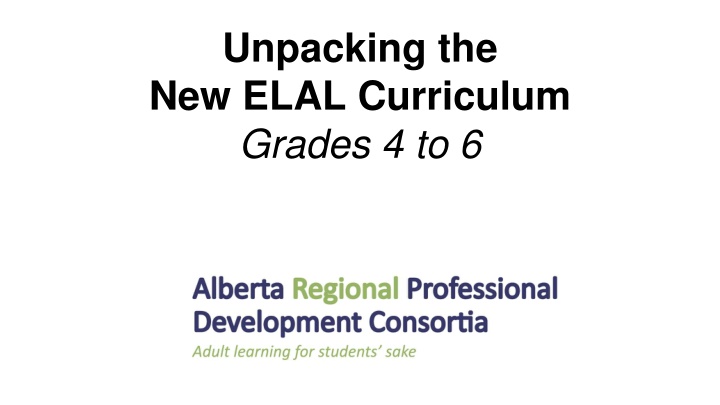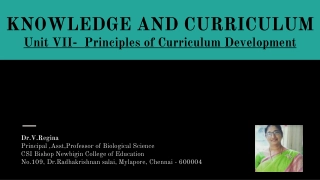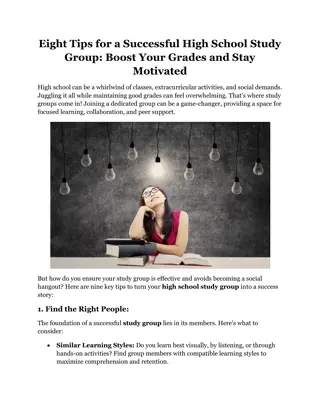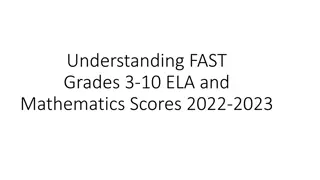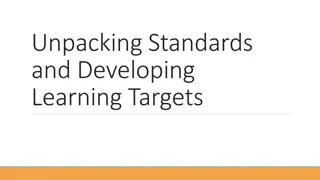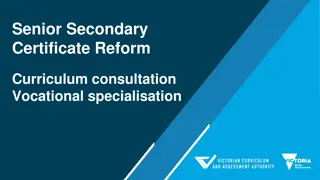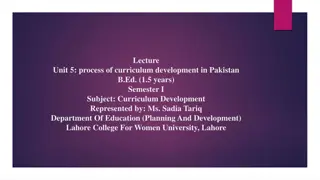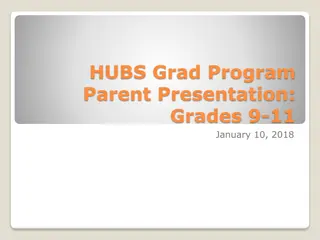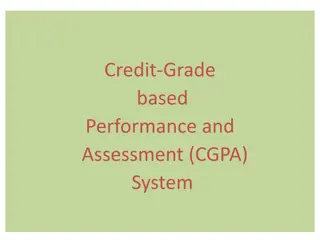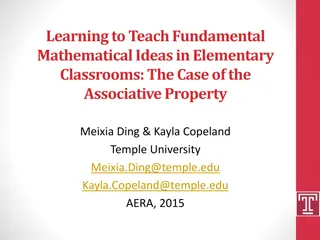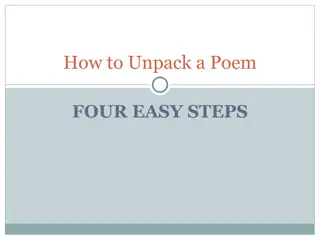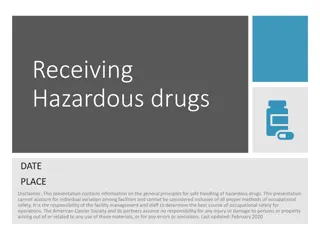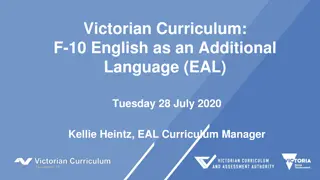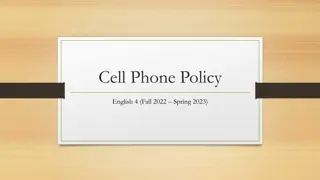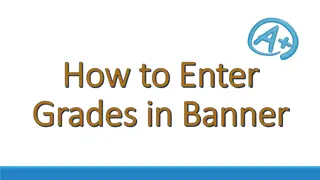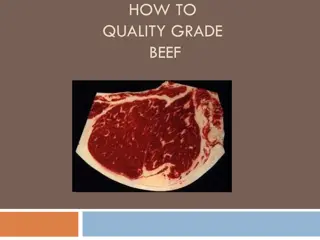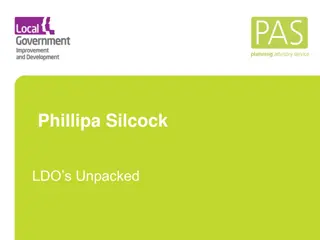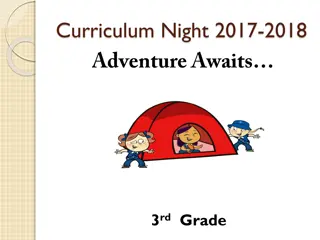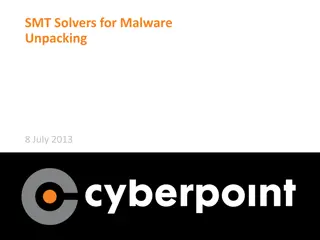Unpacking the New ELAL Curriculum for Grades 4-6
In the spirit of reconciliation, acknowledgment of traditional Treaty lands in Alberta is highlighted, emphasizing the importance of understanding Indigenous history. The journey to the new curriculum is depicted along with the direction for curriculum development in Alberta, focusing on promoting skills acquisition, knowledge pursuit, and values of equality, excellence, and respect. The guiding framework provides transparent guidelines for curriculum understanding, outlining the importance of curriculum content and development. Language Arts and Literature curriculum aims to enhance students' language skills, reading comprehension, writing proficiency, and appreciation of diverse literary works.
Download Presentation

Please find below an Image/Link to download the presentation.
The content on the website is provided AS IS for your information and personal use only. It may not be sold, licensed, or shared on other websites without obtaining consent from the author.If you encounter any issues during the download, it is possible that the publisher has removed the file from their server.
You are allowed to download the files provided on this website for personal or commercial use, subject to the condition that they are used lawfully. All files are the property of their respective owners.
The content on the website is provided AS IS for your information and personal use only. It may not be sold, licensed, or shared on other websites without obtaining consent from the author.
E N D
Presentation Transcript
Unpacking the New ELAL Curriculum Grades 4 to 6
In the spirit of reconciliation, we want to acknowledge that this gathering is taking place on traditional Treaty lands across the province of Alberta - home to many diverse Indigenous, M tis and Inuit peoples. Spanning generations, acknowledgement of the land is a traditional custom of Indigenous peoples and an important part of reconciliation. It gives voice to the authentic history of the land and its original people. Honouring the land in this way acknowledges the story of the creation of this country in a way that has historically been missing. Treaty Acknowledgement 2
The Journey to the New Curriculum
Direction for Curriculum Ministerial Order on Student Learning Vision for Student Learning Foundations for Learning Outcomes for Learning Education in Alberta will promote the acquisition of skills and the pursuit of knowledge with wisdom, while valuing equality of opportunity, parental responsibility, personal responsibility and excellence, and respect for difference and the inherent dignity of each individual. 4
The Guiding Framework provides transparent guidelines to help parents and educators understand curriculum development in Alberta. guides curriculum development. Curriculum is the content what students learn and why it is being taught in each subject from grade to grade. 2020 5
Language Arts and Literature Students will learn: to apply phonics, spell words correctly, expand vocabulary, and read with fluency to comprehend (summarize, recall, synthesize, draw inferences) and interpret types of text the difference between fact and opinion and to evaluate, use, and record information ethically from a variety of sources to summarize, analyze, and discuss the arguments as presented by an author to view, appreciate, and analyze various texts and media to speak and present in various contexts through coaching for skillful public speaking to write in various genres for a variety of audiences the art of listening well and charitably (even to opposing views) to use socially and culturally appropriate verbal and non-verbal communication skills (e.g., respectful and inclusive dialogue, body language, tone, clarity of speech) to compose and revise their own texts with attention to correct spelling; vocabulary; punctuation; grammar; and sentence, paragraph, and essay or story structure for a variety of audiences to develop various techniques for adding elements of beauty and persuasion to their composition of texts with their audience in mind to appreciate a body of age-appropriate unabridged stories, fables, poetry, myths, oral traditions, plays, films, novels, and non- fiction texts that all children in Alberta will have in common, forming a foundation of cultural knowledge and a sense of historical continuity and change within the tradition of the language being studied to read a diversity of the greatest and most influential writers whose works show that we as humans have much in common that transcends differences and helps us find our own unique voice that texts from many traditions have shaped our society and the primary language being studied, including many texts brought in from other languages (e.g., The Odyssey, Beowulf, Aesop s Fables, Indigenous legends)
Navigating the New Curriculum
Go to New Learn Alberta Go to NewLearnAlberta
3 Common Features Across All Subjects Architecture and Design Learning Outcomes Clear and Concise Language
Unpacking the Curriculum in ELAL
REMEMBER: Curriculum and Pedagogy Curriculum is the what to teach and not the how to teach.
What is English Language Arts & Literature? Alberta Education says (adapted) A structured system as the basis for thinking, communicating and learning Engagement with a wide variety of texts offers opportunities to expand thinking beyond personal experiences and to think critically and explore creative expression Help students develop deep understandings of others and themselves, build interpersonal relationships and engage in responsible citizenship Provides a solid foundation in language, literacy and literature to support students in achieving personal and academic goals
Literacy involves acquiring and applying the understandings necessary to: decode evaluate logically communicate ideas build meaning Image from joyinreading.org
Foundational Literacy: Specific to Decoding Phonological awareness Phonics Identify and manipulate sounds in ORAL language Understand relationships between sounds and letters Fluency in order to read a range of texts accurately, automatically, and with expression Comprehension-students apply foundational knowledge in order to demonstrate comprehension of increasingly complex messages Image from teachphonics.blog
In Writing: Apply comprehension of messages and expand verbal and written vocabulary through the study of word meaning, origins and structures Explore ways to share ideas and respond to text Students apply writing processes and language conventions to organize ideas and communicate effectively & form opinions based on research
Phonemic Awareness Phonics Let s remember the 5 Pillars of Reading (National Reading Panel 2000) Fluency As we Discuss Structured Literacy Vocabulary Comprehension
LANGUAGE COMPREHENSION STRAND: Strand One: Background Knowledge Strand One: Background Knowledge The knowledge and experience a child brings to reading It is the knowledge of what has been gained in the world Background knowledge will vary from person to person Background knowledge strengthens our comprehension 24
LANGUAGE COMPREHENSION STRAND: Strand Two: Vocabulary Strand Two: Vocabulary Part of and works with Background Knowledge, Verbal Reasoning, Comprehension We learn words through our Social and Academic experiences 25
LANGUAGE COMPREHENSION STRAND: Strand Three: Language Structures Strand Three: Language Structures (Of Yoda from Star Wars you should think) (Of Yoda from Star Wars you should think) Syntax and Semantics (so, grammar/meaning!) Understanding how words go together to convey meaning Arrangement of words in a phrase or sentence Lots of patterns and rules Build comprehension How language works 26
LANGUAGE COMPREHENSION STRAND: Strand Four: Verbal Reasoning (connections) Strand Four: Verbal Reasoning (connections) The Grocery store was a zoo! Think: Amelia Bedelia ( dressing the turkey or drawing the drapes ) Combining knowledge and vocabulary Express that knowledge and vocabulary through verbal reasoning Make connections to move ideas, understanding and connections further The means to problem-solve and deepen our knowledge 27
LANGUAGE COMPREHENSION STRAND: Strand Five: Literacy Knowledge Strand Five: Literacy Knowledge A wide exposure to a variety of literary styles Gives students a more developed framework on which they can rely as they read more and more for themselves Exposure to a variety of stories, stories with different themes, from different cultures and for different purposes. When a student is able to connect something they are reading to a story/text/theme/purpose they have already internalized, they will be better able to understand and stick with it through challenges. 28
The Work of Constructing Meaning The Work of Constructing Meaning THE STRANDS ARE A METAPHOR FOR READING THE STRANDS ARE A METAPHOR FOR READING WEAVING ALL THE STRANDS TOGETHER IS NECESSARY WEAVING ALL THE STRANDS TOGETHER IS NECESSARY ANY FRAYED STRAND CREATES A BREAKDOWN ANY FRAYED STRAND CREATES A BREAKDOWN
Details of the Structured Literacy Approach 33
Structured Literacy requires: PHONICS AND WORD RECOGNITION FLUENCY VOCABULARY WRITTEN EXPRESSION LISTENING AND READING COMPREHENSION PHONOLOGICAL AWARENESS
Curriculum Connections:
Competencies Critical Thinking Problem Solving Research and Managing Information Creativity and Innovation Communication Collaboration Citizenship Personal Growth and Well-being 36
Awareness Rules of language Acquire Information Construct Meaning Communicate Meaning Literacy Progressions 37
Subject Specific Overview
Bridging Documents for ELAL (found under Curriculum Implementation hub)
New: ELAL ORGANIZING IDEAS: 1. Text Forms and Structures 2. Oral Language Current ELA STRANDS: Students will listen, speak, read, write, view and represent to: 1. explore thoughts, ideas, feelings and experiences 1. explore thoughts, ideas, feelings and experiences New: ELAL ORGANIZING IDEAS: Current ELA STRANDS: Students will listen, speak, read, write, view and represent to: 1. Text Forms and Structures 3. Vocabulary 2. Oral Language 4. Phonological Awareness 1. comprehend and respond personally and critically to oral, print and other media texts comprehend and respond personally and critically to oral, print and other media texts 3. Vocabulary 5. Phonics 1. 6. Fluency 4. Phonological Awareness 7. Comprehension 1. manage ideas and information 5. Phonics 8. Writing 1. 1. enhance the clarity and artistry of communication enhance the clarity and artistry of communication manage ideas and information 6. Fluency 9. Conventions 1. 1. respect, support and collaborate with others. respect, support and collaborate with others. 7. Comprehension 1. 8. Writing
EXAMPLE: Grade 5 ELAL Curriculum
Documents - New and Previous Curriculum (CARC) Grade 4 Comparison Grade 5 Comparison Grade 6 Comparison 45
Curriculum Connections:
CURRICULUM MATCH! In your grade group, connect the OI & GQ to LO to KUSPs
Sound Walls What are they and how to implement them? (2 part series; by Kelly Gibbs, ERLC) 50
